#Importance of English Language in India
Explore tagged Tumblr posts
Text
Harnessing the importance of English Language in India

In the fast-paced and interconnected world of the 21st century, the English language has emerged as a powerful tool for progress and prosperity in India. Let's explore how harnessing the importance of English language is transforming various aspects of Indian society.
Economic Growth:
English language proficiency is closely linked to economic growth and development in India. As a global language of business and commerce, English opens doors to lucrative employment opportunities in sectors such as IT, finance, hospitality, and tourism. Many multinational corporations and international organizations prefer to conduct their operations in English, creating a demand for skilled professionals who can communicate effectively in the language. By equipping its workforce with English language skills, India can attract foreign investment, foster entrepreneurship, and drive innovation, thus fueling economic growth and creating job opportunities.
Educational Empowerment:
English language proficiency is synonymous with educational empowerment in India. English-medium education is often associated with quality education and access to prestigious institutions. Many of India's top universities and professional colleges offer courses in English, attracting students from diverse linguistic backgrounds. Proficiency in English enhances students' academic performance, facilitates research and knowledge exchange, and prepares them for global career opportunities. Additionally, English language skills are essential for accessing online educational resources, participating in international exchange programs, and pursuing higher education abroad.
Social Mobility:
English language proficiency plays a crucial role in promoting social mobility and upward mobility in Indian society. Individuals who are proficient in English have a competitive edge in the job market and are more likely to secure well-paying jobs and career advancement opportunities. English proficiency also enables individuals to navigate social networks, access information and resources, and participate actively in civic and political life. By promoting English language education and literacy, India can empower marginalized communities, bridge the urban-rural divide, and promote social inclusion and equality.
Global Engagement:
English language proficiency facilitates India's global engagement and diplomacy on the world stage. As a country with a rich cultural heritage and diverse linguistic landscape, India leverages English as a common language of communication with international partners, institutions, and audiences. English proficiency enables Indian diplomats, policymakers, and business leaders to negotiate trade agreements, participate in international forums, and represent India's interests effectively on the global stage. Additionally, English language proficiency enhances India's soft power and cultural influence, as Indian literature, films, music, and media reach global audiences and contribute to cross-cultural understanding and cooperation.
Conclusion:
In conclusion, the importance of the English language in India transcends linguistic boundaries and opens doors to a world of opportunities. By harnessing the economic, educational, social, and diplomatic potential of English language proficiency, India can accelerate its journey towards progress, prosperity, and global leadership in the 21st century.
#education#english language#importance of english language#Importance of English Language in India#English in Education#Global Communication#Cultural exchange
0 notes
Text
it’s terrible but funny seeing how many problems have been caused by nerds trying to gatekeep “nerdy” topics and extrapolating to terrible and bizarre political extremes (see Yarvin and Thiel).
meanwhile electric trains are anything but gatekept and still remain incurably nerdy in the Anglophone world. Just not something the algorithm pushes or that there’s much glamorized media for general public about. But then they’re so well documented and sources that do exist are all written by people who are electrical engineers, have worked with them for 30+ years, or have a PhD or close alignment with elite universities. Media that seriously discusses them is so slop-free it’s weirdly impressive, because they are the perfect mix of alien and unknowable to most but also 100+ year old tech that isn’t as “cool” anymore
#their fanbase outright evangelizes it WANTS people to know and understand this stuff#because it’s surprisingly important and not widely understood#even early history has had huge effects on how things work today. like old lines having lower AC frequency and newer lines having 50/60Hz#and then you need multi-system trains because it’s cheaper than replacing the infrastructure (and batteries are very limited)#they are not like electric road vehicles they have all kind of different issues (and COLOSSAL ADVANTAGES)#they’re uniquely convenient to electrify via sliding direct contact vs batteries and it’s why they’re so old and powerful#not having to carry your own power supply is a massive advantage and why they mop the floor with every other kind of train performance wise#(and english language media SO undersells this by ignoring them or only showing them as subways and high speed trains#because they’re also GREAT for freight and many don’t realize because most freight heavy countries barely use them#They’re mostly dieselized and highly electrified countries tend to be passenger heavy BUT just look at IORE or India#or the early 20th century US and the rabbit hole of giant early electric locomotives. like Big Boy sized
1 note
·
View note
Text
Dick Grayson is drawn fine the way he is and claiming he isn’t is colourist. I’ll tell you why
First and foremost I would like to specify there will be mistakes in this rant as English is my third language and I am also Romani so obviously this gives me grounds to speak on this matter
Onto the rant I will start this by saying no matter how the Romani person appears - Roma are not white no matter how white passing a Romani person may look. Romani is also not specifically a race it is an ethnic group which depending on the subgroup can vary but most Roma simply consider ourself brown or will forego that and just state that they’re Romani
In this fandom there are a lot of misguided beliefs that dick Grayson is drawn “wrong” or that he is “white washed” in comics or fan arts which has resulted in harassment to people who haven’t done anything wrong
Roma don’t have a “look” there are millions of Roma world wide who look vastly different - there will never be a specific wrong way to draw dick Grayson because there is no right way to look Romani.
There are blond haired blue eyes entirely Roma just as there are dark skinned textured hair Roma
This leads me to: why do Romani people have such varying looks?
Romani people come from India and left India roughly 1,000 years ago and then settled all over the world but most of which went to Europe - where you will find the most variant subgroups of Roma.
European Roma faced slavery and attempts of ethnic cleansing for almost 5 centuries in which women were raped and Roma were killed - then almost 100 years later the holocaust happened which was the largest on scale genocide and ethnic cleansing of Roma there was.
This caused overtime majority of Western and northern European Roma to become paler and more white passing while today Roma from Far Eastern and southern Europe usually tend to be darker skinned
During American slavery it wasn’t just Africans who were taken forcefully to America but also Roma who had settled in Africa - along with Europe sending European settled Roma to America for the same purpose.
In the modern day Romani descendants of that are darker skinned as opposed to European Roma being lighter skinned
Of course - tragedies don’t dictate how Roma will look in the modern day, you can imagine when your ethnic group and your community has stayed in one place for hundreds of years you will at least start to look a little of like the people of the place you are.
Roma don’t throw people out of their community for not looking “Romani enough” white passing Roma are considered light skinned Roma and darker skinned Roma are considered dark skinned Roma - we are all Romani and we all belong to our Romani communities.
Claiming a Romani character or person doesn’t look right or is white blatantly ignores the tragedies Roma faced which caused communities of Roma to look the way they do - there is no such thing as not looking right as Roma and the level of how Romani you are is not dictated by the colour of your skin.
And while we never know what subgroup of Roma dick Grayson it is safe to assume he is romanichal (subgroup of Roma from the uk and other English speaking countries) of course until dc ever specifies otherwise.
His subgroup isn’t important but it could shed light on the struggles his community faced in the current and in the past.
Dick Grayson’s Romani identity isn’t decided by his skin it is decided by who he is and who he is is Rrom.
I could go into more intricate detail of Romani culture which is seemingly always butchered in fandom (especially in relation to language) but I will save that for another post

#roma dick grayson#romani dick grayson#dick grayson#nightwing#dc universe#dc comics#dcu comics#dcu#batfamily#batfam
622 notes
·
View notes
Text
Tamil Linguistics thread (bc nobody cares but me)
but really, if you are interested in linguistics at all, give this post a read, because this shit really blew my mind ...
have been reading the following paper: https://ccat.sas.upenn.edu/~haroldfs/public/h_sch_9a.pdf
"The Tamil Case System" (2003) written by Harold F. Schiffman, Professor Emeritus of Dravidian Linguistics and Culture, University of Pennsylvania
Tamil is one of the oldest continuously-spoken languages in the world, dating back to at least 500 BCE, with nearly 80 million native speakers in South India and elsewhere, and possessed of several interesting characteristics:
a non-Indo-European language family (the Dravidian languages, which include other languages in South India - Malayalam being the most closely related major language - and one in Pakistan)
through the above, speculative ties to the Indus Valley Civilization, one of the first major human civilizations (you can read more about that here)
an agglutinative language, similar to German and others (so while German has Unabhängigkeitserklärungen, and Finnish has istahtaisinkohankaan, in Tamil you can say pōkamuṭiyātavarkaḷukkāka - "for the sake of those who cannot go")
an exclusively head-final language, like Japanese - the main element of a sentence always coming at the end.
a high degree of diglossia between its spoken variant (ST) and formal/literary variant (LT)
cool retroflex consonants (including the retroflex plosives ʈ and ɖ) and a variety of liquid consonants (three L's, two R's)
and a complex case system, similar to Latin, Finnish, or Russian. German has 4 cases, Russian has at least 6, Latin has 6-7, Finnish has 15, and Tamil has... well, that's the focus of Dr. Schiffman's paper.
per most scholars, Tamil has 7-8 cases - coincidentally the same number as Sanskrit. The French wikipedia page for "Tamoul" has 7:
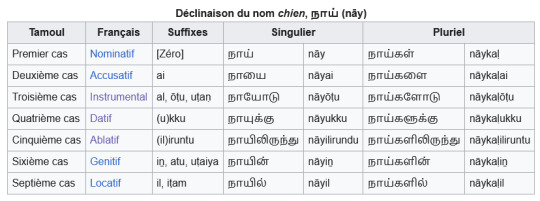
Dr. Schiffman quotes another scholar (Arden 1942) giving 8 cases for modern LT, as in common in "native and missionary grammars", i.e. those written by native Tamil speakers or Christian missionaries. It's the list from above, plus the Vocative case (which is used to address people, think of the KJV Bible's O ye of little faith! for an English vocative)
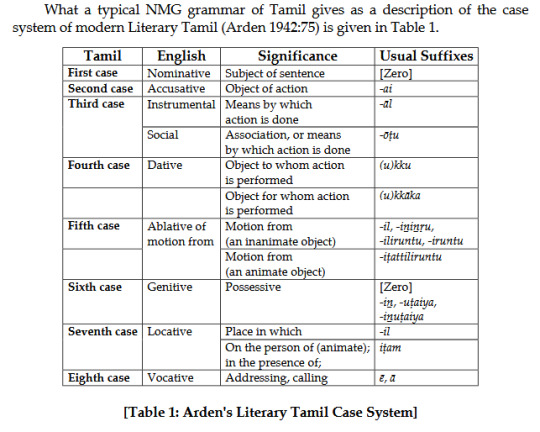
... but hold on, the English wiki for "Tamil grammar" has 10 cases:
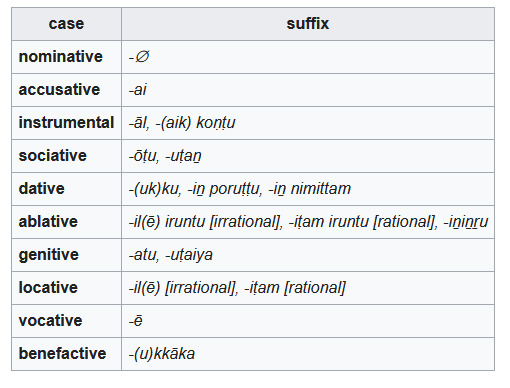
OK, so each page adds a few more. But hold on, why are there multiple suffix entries for each case? Why would you use -otu vs. -utan, or -il vs -ininru vs -ilirintu? How many cases are there actually?
Dr. Schiffman explains why it isn't that easy:
The problem with such a rigid classification is that it fails in a number of important ways ... it is neither an accurate description of the number and shape of the morphemes involved in the system, nor of the syntactic behavior of those morphemes ... It is based on an assumption that there is a clear and unerring way to distinguish between case and postpositional morphemes in the language, when in fact there is no clear distinction.
In other words, Tamil being an agglutinative language, you can stick a bunch of different sounds onto the end of a word, each shifting the meaning, and there is no clear way to call some of those sounds "cases" and other sounds "postpositions".
Schiffman asserts that this system of 7-8 cases was originally developed for Sanskrit (the literary language of North Indian civilizations, of similar antiquity to Tamil, and the liturgical language of Vedic Hinduism) but then tacked onto Tamil post-facto, despite the languages being from completely different families with different grammars.

Schiffman goes through a variety of examples of the incoherence of this model, one of my favorites quoted from Arden 1942 again:

There is no rule as to which ending should be used ... Westerners are apt to use the wrong one. There are no rules but you can still break the rules. Make it make sense!!
Instead of sticking to this system of 7-8 cases which fails the slightest scrutiny, Dr. Schiffman instead proposes that we throw out the whole system and consider every single postposition in the language as a potential case ending:
Having made the claim that there is no clear cut distinction between case and postpositions in Tamil except for the criterion of bound vs. unbound morphology, we are forced to examine all the postpositions as possible candidates for membership in the system. Actually this is probably going too far in the other direction ... since then almost any verb in the language can be advanced to candidacy as a postposition. [!!]
What Schiffman does next is really cool, from a language nerd point of view. He sorts through the various postpositions of the language, and for each area of divergence, uses his understanding of LT and ST to attempt to describe what shades of meaning are being connoted by each suffix. I wouldn't blame you for skipping through this but it is pretty interesting to see him try to figure out the rules behind something that (eg. per Arden 1942) has "no rule".


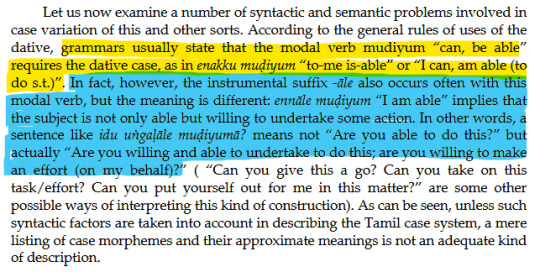
On the "extended dative", which connotates something like "on the behalf of" or "for the sake of":
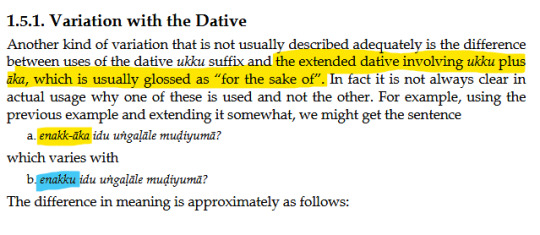

I especially find his analysis of the suffix -kitte fascinating, because Schiffman uncovers a potential case ending in Spoken Tamil that connotes something about the directness or indirectness of an action, separate from the politeness with which the person is speaking to their interlocutor.


Not to blather on but here's a direct comparison with Finnish, which as stated earlier has 15 cases and not the 7-8 commonly stated of Tamil:
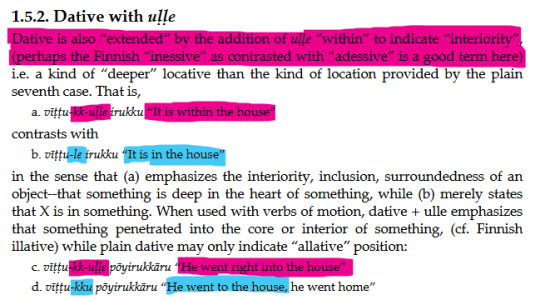
What Schiffman seems to have discovered is that ST, and LT too for that matter, has used existing case endings and in some cases seemingly invented new ones to connote shades of meaning that are lost by the conventional scholar's understanding of Tamil cases. And rather than land on a specific number of cases, he instead says the following, which I find a fascinating concept:
The Tamil Case System is a kind of continuum or polarity, with the “true” case-like morphemes found at one end of the continuum, with less case-like but still bound morphemes next, followed by the commonly recognized postpositions, then finally nominal and verbal expressions that are synonymous with postpositions but not usually recognized as such at the other extreme. This results in a kind of “dendritic” system, with most, but not all, 8 of the basic case nodes capable of being extended in various directions, sometimes overlapping with others, to produce a thicket of branches. The overlap, of course, results from the fact that some postpositions can occur after more than one case, usually with a slight difference in meaning, so that an either-or taxonomy simply does not capture the whole picture.
How many cases does Tamil have? As many as its speakers want, I guess.
175 notes
·
View notes
Text

Teresa, or Teresia Sampsonia, Lady Shirley (1589–1668)
Artist: Sir Anthony Van Dyck (Flemish, 1599-1641)
Date: 1622
Medium: Oil on canvas
Collection: National Trust Collections, United Kingdom
Description
Teresa Sampsonia (born Sampsonia; after marriage Lady Shirley, 1589–1668) was an Iranian-English noblewoman of the Safavid Empire of Iran. She was the wife of Elizabethan English adventurer Robert Shirley, whom she accompanied on his travels and embassies across Europe in the name of the Safavid King (Shah) Abbas the Great.
Teresa was received by many of the royal houses of Europe, such as English prince Henry Frederick and Queen Anne (her child's godparents) and contemporary writers and artists such as Thomas Herbert and Anthony van Dyck. Herbert considered Robert Shirley "the greatest Traveller of his time", but admired the "undaunted Lady Teresa" even more. Following the death of her husband from dysentery in 1628, and due to impediments from grandees at the court, and the authorities, during the reign of Abbas's successor and grandson Safi (r. 1629–1642), Teresa decided to leave Iran. She lived in a convent in Rome for the rest of her life, devoting her time to charity and religion. As a pious Christian, and because of her love for her husband, Teresa had Shirley's remains transported to Rome from Isfahan and reburied; on the headstone of their mutual grave she mentions their travels and refers to her noble Circassian origins.
Thanks to her exploits, Teresa has been described as someone who subverted patriarchal gender roles common to the Muslim and Christian cultures of her time. Due to their hybrid identities and adventures, Teresa and her husband became the subject of several contemporary literary and visual works. Nevertheless, the story of Teresa as an important woman of the 17th century has been largely overshadowed and obscured by the tale of her husband Robert and his brothers.
Together they made two extended voyages across Europe. In 1611 they travelled to England where Teresa gave birth to their son, Henry. In 1613 they returned to Isfahan on an East India Company ship. The Shirleys continued to travel over the next decade to India, Portugal, Spain and Italy. They went to Rome in 1622, and this picture and the pendant portrait of Robert can be dated to Van Dyck's first visit to the city.
Van Dyck’s training with Rubens had sharpened his eye for the enriching effect offered by sumptuous garments such as those worn by Lady Shirley. Van Dyck had also recently begun to absorb the lessons of Titian and the other great Venetian colourists.
Teresa was a gifted linguist and spoke more than half a dozen languages. Historian Bernadette Andrea recounts how she saved her husband’s life on at least two occasions: ‘once as they set off on their first journey when his Persian enemies sought to kill him, which earned her the accolade "a true Amazon" and again when the couple encountered hostile Portuguese traders on their way to Goa.’ (See the entry for 'Lady Teresa Sampsonia Sherley' in the Oxford Dictionary of National Biography).
After Robert’s death, Teresa was accused of the capital crime of apostasy and her property was confiscated. She became a fugitive, hiding in an Augustinian church in Isfahan and an Armenian convent just outside the Safavid capital. She received a special permit to travel, went to Istanbul for three years and then on to Rome where she settled and remained for more than three decades until her death in 1668.
#portrait#teresa sampsonia#safavid empire of iran#golden dress#persian rug#seated#veil#jewels#iranian noblewoman#oil on canvas#artwork#fine art#oil painting#iranian history#anthony van dyck#flemish painter#national trust collections#flemish art#17th century painting#european art
29 notes
·
View notes
Text
Axl Low Theory: "His parents were hippies."
Alright, I may not be the person who knows the most when it comes to the game's lore, but this theory is mostly based on some things I noticed that made sense to me. So, please don't take it too seriously; I made it for fun and to share some thoughts.
Also, English isn't my first language so I tried to use some tools so you could understand this sh**
Another thing is READ ALL if you want to understand my point, I know Axl is a British man and hippies were almost americans, I know his parents are rich and they may disinherit him, but please, read 'cause I treat those points in a way or another.
Let’s set the stage with a bit of context:
The hippie movement started in the United States, especially in San Francisco (California), as a reaction against materialism, the Vietnam War, racism, and the social conservatism of the time.
Here are some key values that probably sound familiar to many of you, but let’s refresh them anyway:
☮️-A total rejection of violence and war: The hippies were pacifists through and through.
☮️-Anti-consumerism: They preferred a simpler, more communal life and criticized the growing consumerism of American society.
☮️-Criticism of traditional monogamy and sexual norms, especially those upheld by 1950s American Christianity.
☮️-Interest in Eastern religions, astrology, and mysticism, rejecting mainstream Christianity.
☮️-Respect for nature and a sustainable lifestyle.
☮️-And, of course, the experimentation with drugs like LSD to expand consciousness. (This isn't the most important)
It’s worth noting that this movement wasn’t entirely altruistic. It’s known that many hippies were actually wealthy people who didn’t want to go to war or just wanted to live a carefree, ‘hippie’ lifestyle to escape family pressure. But that doesn’t mean their cause wasn’t legitimate. There were many who genuinely believed in it. Being a hippie doesn't mean you can't be prejudiced and horrible. Besides, people often have ideas when they're young that change when they grow up. Nobody is completely the same thing in their youth compared to their adulthood (30-40)
Also, hippies were persecuted by the police and society during those years. They were often spied on by the FBI under programs like COINTELPRO, aimed at controlling and dismantling countercultural movements. Many also faced discrimination for their appearance, lifestyle, and ideologies.
This led to some of them migrating to rural communes or even to countries like Mexico and India, seeking freedom of worship and less oppressive environments (Or even being prosecuted by the law for drug possession). Some even went to China.
Now, let’s focus on Axl.
No introduction needed; Axl is one of the most iconic characters from the game. He has the unique trait of being a time traveler, specifically from the '90s, which brings me to my first point:
Axl doesn’t quite fit the mentality of the 1990s. The '90s were a time marked by pessimism due to economic and political tensions. This decade saw a rise in sarcasm, satire, and dark humor in media, and entertainment reflected this shift. Think of shows like Ren and Stimpy, the rise of grunge music, comics like Punisher, and video games like Doom. Even kids hated figures that represented positivity, such as Barney.
Axl, on the other hand, stands out for his optimism and his perseverance despite adversity. While he does have his own tragic past, he faces it with humor and constantly strives to be a better person. He’s also a pacifist, always seeking peaceful resolutions, even though he has a history of gang involvement. A pacifist gang member from the '90s? That’s an odd combo.
Now, some might argue that Axl’s background doesn’t quite match the hippie culture. According to the game wiki, Axl comes from a wealthy family but grew up in a dangerous neighborhood in England. This raises a couple of questions:
-Why would wealthy people live in a dangerous area?
-And, if Axl grew up there, why isn’t he more violent like many of the others in his neighborhood?
-Another thing: Axl seems to live simply. His clothes aren’t particularly luxurious, and he eats at places like McDonald’s and hangs out at open-air markets, which suggests a more humble lifestyle. If his family is supposed to be rich, why is he living like that?
You might be asking, "Why are his parents, and not Axl himself, the hippies?"
Well, Axl embodies only a few of the values of the movement, but his parents seem to represent the broader spirit of the hippie culture more directly. Axl is a young adult in the '90s, so he’d likely be between 23-27 years old (I’m guessing he was born between 1971-1975, based on estimates of his age and his time travel experiences). That places him in the 1970s for his childhood, when his parents were likely still deeply influenced by the movement.
(FOR THIS PART, IS NECESSARY FOR ME TO SAY I'M NOT A NATIVE ENGLISH SPEAKER, PLEASE THIS POINT IS ONLY FROM MY LISTENING OF MY SECOND LANGUAGE AND I KNOW I HAVE A BIG PROBABILITY OF SAYING NONSENSE HERE)
Now, here’s the part that might seem a bit weak, but hear me out: Axl’s accent. If you listen closely, you’ll notice that Axl’s English doesn’t quite sound British. It’s more like an American trying to sound British, especially in Strive and XRD. Maybe his parents weren’t British, and Axl grew up with a mixed accent because his parents were from a different place, but the world around him spoke with a British accent.
Now the theory itself:
Axl’s parents could have been a hippie couple who fled the United States during the 1970s. They might have moved to England to escape the oppressive social and political climate in America. I’m suggesting they’re Americans because of Axl’s American-style English, though it’s possible they were British hippies who’d returned to the UK after their time in Asia with other hippie communes.
They likely decided to settle down in the 1970s when they found out they were having a child. True to their hippie values, they chose to live in a poor, rundown neighborhood, away from the luxuries they could afford. However, they made sure Axl didn’t want for anything materially. More importantly, they instilled in him their values without forcing him into a particular path in life, allowing him the freedom to choose his own.
Growing up in such a neighborhood, Axl witnessed the violence and struggle around him, which only strengthened his commitment to his parents’ pacifist ideals. He likely heard stories of the persecution his parents faced, and perhaps this inspired him to act and try to bring peace to his community.
With all this in mind, I believe the environment in which Axl grew up played a big role in shaping who he became. His parents’ influence is clear, but the place he lived and the experiences he had contributed just as much to his growth. But of course, they only believed in this part of their cause, they might have changed their mind living in London and maybe they never believed in all of this and only looked for easy drugs, being that the reason or their persecution, or were a bit classist and racist, that's why they rejected Axl when he decided to live his life with Megumi.
Well, that's all guys, hope you like it... Don't take me seriously please, I say this only from the perspective of a weird stupid fan of Axl Low, i know this may be more a headcanon than a theory itself qwq

17 notes
·
View notes
Text
WHY TF IS HINDI BEING FORCED ON THE OTHER STATES? (What's the difference between this and colonization?)
Comments under a video where a person was trying to defend his language by speaking against the policy:
@Jai_Bharath_Jai_Sriram People of India from different parts of India are fighting each other in English to save their local language. This is the beauty of India. Everywhere and every time, politics
@myguitarguru1635 They are Looser...they are Corrupted. .why dnt he talk in Tamil ? They make people Fool.. Vande Maataram Vande HINDUTVA
@bhalkitoday8267 No problem lose your Tamil culture
@secularsaint7991 Talking in english while defending tamil.. such hypocrites XD @shiny2308 That's why you were able to understand it @secularsaint7991 If he had talked in hindi, a lot more people would have understood the point.
(My friend's opinion)
I am from the South but live in the North. I learned Hindi ever since I was young but was never that serious about the language since I'm not a native, and there are some specific Hindi roots and terms that I am not familiar with. I do not accept the act of forcing Hindi onto other states.
AFTER ALL, WHETHER A LAW, RULE, OR TREND IS FAIR OR NOT DEPENDS ON WHETHER OR NOT THE PERSON IS BENEFITTING FROM IT.
Everyone's idea of being fair is different. If you were a native Hindi speaker, you would find the law great. However, if you are not a native Hindi speaker, you would think that it is unfair that another language or culture is being forced onto you. It would feel no different from how English was forced onto the Indians by the British and how Islam was forced onto the civilians by Islamic rulers.
Note that India is not just a country but, like a miniature of the world, holds many cultures together as states. For unity, we must respect each and every one around us and not force our beliefs on others.
The reason why the South people are against it is because a different language and culture are being forced onto them under the movement of 'Hindustan' emotions to unite Indians together. However, forcing something specific will not UNITE but DIVIDE.
After our independence, the first Telugu state was formed because they demanded respect for their culture and language, and not to have another foreign language forced onto them.
I have seen many people disrespect English. However, I feel that the language is essential in our country, since it unites Indians from different states together and gives them a chance to communicate.
Notice that people from the South that you are communicating with are talking to you in English, not Hindi. English is a comfortable and common language that has been taught to the two of you at a young age, so the people from the South feel more comfortable talking in English than talking in Hindi.
Also, it is basic in a conversation to engage yourself by using easy words or actions if the person you are talking to does not understand your language clearly. However, if you expect the person to speak to you in Hindi but you will not even say a word in their native language, then that will make you rude and egoistic. That is why the fellow southies use English to speak to the Northies. Even I sometimes use English with my relatives and cousins if I ever get stuck in my mother tongue.
My conclusions on this matter:
1) Do not boycott the English language, since it unites different states. And to those who use this language by being a classist, shame on you, too.
2) Do not force any specific language. After all, under the constitution, Hindi is an official language just like the others. It holds equal importance as any other official language and thus cannot be forced. Hindi is NOT the national language.
3) There has been a discussion going on to implement two official languages in the curriculum. I feel as if that is a better decision. But well, let's see what happens.
(EDITED) 4) How about teaching Sanskrit and Vedic math to little children? Let's not force another language onto students, who are dealing with enough peer pressure and studying pressure.
#desiblr#hindublr#india#desi tumblr#hindutva#hindi#tamil#telugu#hindipolicy#politics#colonization#dontforceyourlanguageontous#representation#language#culture
12 notes
·
View notes
Note
So everyone in your human AU who has a "robot" name in vanilla has been given a "normal" name except Uzi, which to my knowledge isn't a usual name to see (?). Apparently it is an obscure Hebrew name, but it's rarely used, and your Uzi is of Indian heritage, so her parents probably weren't Jewish (although it is a valid possibility, I just feel like you'd have established that by now if so lol. I could totally see a Jewish Uzi). Then again, "Doorman" also isn't an Indian name, but it still feels like something you wouldn't look twice at if you read it in the credits of a film, you know?
So, yet another nitpicky question asked in good faith out of genuine curiosity, because I am sincerely invested in this AU: why is Uzi named that? Were her parents just especially creative, or somehow connected to Jewish culture? Was she named after the gun? Is it perhaps more of a nickname that stuck, or a shortened version of something else? There are a lot of possibilities here.
Additionally, second tangentially related question: I'm assuming your Uzi was born and raised in America based on the flag in her ref image, but were her parents, or grandparents? What Indian ethnicity/culture(s) does her family identify with, if any, and does she speak any of the 22 Indian languages? Or is she just genetically of Indian descent, with no real connection to any specific "heritage?" (ik being Indian isn't a very big part of her character so you maybe haven't written all this out, and that's cool if so. India just has a lot of cultures in it. It's a very diverse and interesting country. I didn't even know they had 22 languages until I looked it up for this ask, lol. Like, 22 languages?? In one country?? What??)
Man, that turned into like 5 questions, lol. Sorry. In case you couldn't tell, I'm really into your AU right now, lmao. (Also I just went up a dose on Vivance and it's hitting me like a train and I'm chattering like a parrot at anyone who crosses my field of vision lmaooo)
Ok about Uzi, so funny enought we HAVE written about her "heritage", America born, she has little to no connection, genetic ties is basically all, speaks English and some very sparce Russian. But she does cook and likes dabbling and looking up stuff from her heritage but it's not particularly important or close to her.
And this stems from her mum Nori, who is alive in this AU, but due to events that we will talk about when we get to show off Nori, she also has very little cultural heritage and also does not speak any of the Indian languages but she WAS born in India.
Uzi's name is because Nori is weird and likes guns, the Doorman name comes from Khan, American born, who is a Korean / white American something.
🦘
24 notes
·
View notes
Note
do you think the lamb stew kabru mentioned could be some variation of rogan josh?
omg anon I'm so sorry, you sent this message just when my life was going completely insane (tree fell on house, living in a hotel, etc), and I wanted to answer you but I just didn't have time... So I forgot.
And then another anon (or maybe it's still you!) sent me another, similar ask!

Which reminded me that I needed to answer you-- and now them, too!!
Food is not an area of expertise for me, so I had to look up all of these dishes. I'd heard the term "gorkhali" before, and heard of rogan josh, but that's as far as my knowledge went.
Let's talk about what we know about where Kabru comes from and what foods he likes, the food culture of South Asia in the real world, and then we can discuss if any of these dishes might be Kabru's childhood lamb stew!
I've written about the real world cultural references Kui has made with Kabru's character before. Evidence that Kabru is from a fantasy version of South Asia (India/Nepal), and Where exactly in fantasy South Asia is Kabru possibly from?
Two additional data points that suggest Kabru could be from a fantasy version of South Asia are his love of tomatoes, and mutton stew being an important dish from his childhood. What does that mean?
THE CULTURAL OVERLAP BETWEEN INDIA, NEPAL AND TIBET
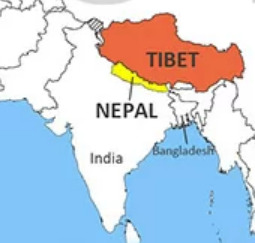
An important thing to note while discussing the cultures of this region is that all three modern countries have a lot of cultural overlap. So many of the foods eaten in one country are also eaten in the other two, with minor variations.
I'm attempting to generalize and speak broadly as best I can, but I am not an expert, so I apologize for any errors on my part. Sometimes finding English-language information on these topics is challenging.
The cuisine of Nepal is a mix of Nepal's own unique culture, plus the influence of its neighbors, India and Tibet.
The Nepali diet primarily consists of rice, wheat, corn, lentils coupled with fresh vegetables and meats. A typical Nepali every-day meal can be characterized by Dal (lentil soups), Bhat (steamed rice) and Tarkari (vegetables), also known as "The Trinity", supplemented by some meat.
STEW OR CURRY?
Though many people think of them as two distinct things, curries are a type of stew, so I think it's valid to look at both stews and curries when trying to identify Kabru's childhood stew.
TOMATOES IN THE CUISINE OF THE INDIAN SUBCONTINENT
Tomatoes turn up in dishes all over the Indian subcontinent, but they are not a traditional ingredient in the local cuisine. Europeans introduced New World foods like chilies, potato and tomato to the region in the 16th century, at which point they were added to the food culture, and in many cases the modern version of these recipes has completely eclipsed the traditional one, both on the Indian subcontinent and abroad.
But while potatoes and chilies were adopted almost immediately, the tomato did not catch on until centuries later, in the 1860s, and they did not become a widespread part of the local culture until the 1960s.
Because of this, the popular global idea of food from the Indian subcontinent often has tomatoes in it, while traditional recipes do not... And this is interesting because Kui tells us Kabru's favorite food is tomatoes! I'm guessing she chose tomatoes because of how common they are in modern Indian food.
Did Kui not know that tomatoes aren't a native part of the cuisine of the Indian subcontinent? It's possible her research didn't go that deep and she just assumed the modern food isn't that different from ancient food.
It's also possible that Kui knew that tomatoes aren't native to the Indian subcontinent, but that Dungeon Meshi has already experienced their version of the Colombian Exchange, because the east and west have had extensive contact with each other for (probably) thousands of years, so then the use of tomatoes in the West (where Kabru is from) would make sense, and doesn't need any further explanation.
MUTTON IN THE INDIAN SUBCONTINENT
Mutton (the term for goat, sheep or lamb meat) is the most consumed red meat in the Indian subcontinent. Goat is the most popular, most likely because it is the cheapest out of the three.
MUTTON IN NEPAL
Like in the rest of the subcontinent, mutton is very popular in Nepal. It is considered a major delicacy, and goat stew/curry is often eaten by Nepali families during important holidays, and for many Nepalis, goat stew/curry is associated with big family gatherings, similar to how Americans think of eating turkey for Thanksgiving, or ham for Easter.
Let's talk about some of the dishes anon(s) asked me about!
ROGAN JOSH

Rogan josh is an aromatic curried meat dish originating from Kashmir. It is made with red meat—traditionally mutton—and colored and flavored primarily by alkanet flower (or root) and Kashmiri chilies. It is one of the signature recipes of Kashmiri cuisine.
A number of origins/meanings of the name have been suggested, such as "stewed in ghee" or "red meat/red juice."
Its characteristic deep red color traditionally comes from dried flowers or root of Alkanna tinctoria (ratan jot) and from liberal amounts of dried, deseeded Kashmiri chilies (lal mirch).
Many modern interpretations of this dish add tomatoes to the sauce. This is especially common with ready-made pour-over cooking sauces to the point that Rogan josh is often described in the modern day as a tomato-based dish.
GORKHALI LAMB


The word Gorkhali (गोर्खाली) is historically synonymous with "Nepali," so Gorkhali lamb could also be called Nepali lamb. The name change, from Gorkhali to Nepali, occurred in the 1930s.
(In the modern day, Gorkha is usually used to refer specifically to military units in the British or Indian army that were made up of men from the North Indian/Nepal region. Starting in 1816 the British East India Company frequently recruited these men as mercenaries, and over time the Gorkhas became very distinguished as exceptional soldiers.)
I couldn't find much about Gorkhali lamb aside from recipes, most of which just echoed the same information, and many of them didn't seem to come from very authentic sources.
From what I've been able to piece together, you make Gorkhali lamb by marinating lamb meat (usually meat on the bone) and cooking it over a charcoal grill. Once it's done, you coat the grilled lamb with a sauce made with chilies and tomatoes, and serve with rice or roti.
I'm not an expert, but it seems like Gorkhali lamb isn't a stew or a curry, it's a sort of marinated, grilled lamb with a sauce. If someone knows more about Gorkhali lamb, please let me know!
Like the Rogan Josh, the addition of tomatoes is a modern invention.
THUKPA

Thukpa is the Tibetan word for any soup or stew with noodles. Thukpa can be prepared in both vegetarian and non-vegetarian variations; the most popular non-vegetarian variation includes chicken, but it is sometimes made with mutton as well.
The Nepalese version of Thukpa is predominant vegetarian, and has a spicier flavor. The protein ingredients are replaced with vegetarian alternatives such as various types of bean.
However, non-vegetarian thukpa is also enjoyed in Nepal, and egg thukpa is probably the second most popular type.
Thukpa is made like most other noodle soups. Some modern recipes include tomatoes in the soup paste, most likely a modern addition.
INDIAN MUTTON CURRIES
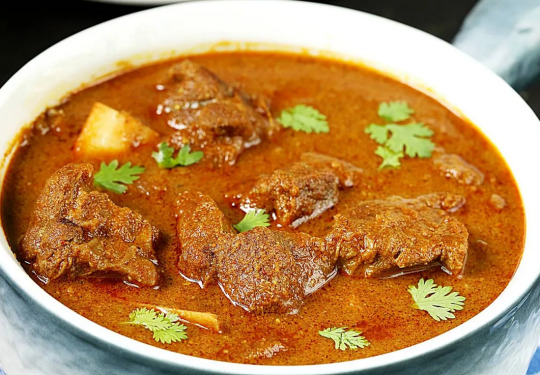
There's many different variations of mutton curry (Kosha mangsho, Mansa kasa, Tapelu, Rezala etc.) throughout the entire Indian subcontinent. Some recipes include tomato, some don't, and as with everything else in this post, the tomatos are a modern addition.
NEPALI MUTTON CURRY
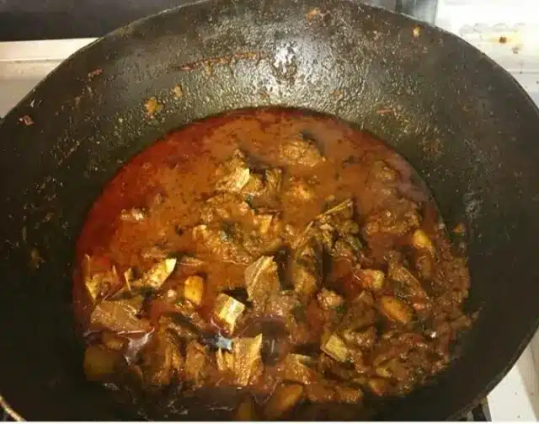
As I said before, mutton is incredibly popular in Nepal. It's reserved for special occasions and celebrations, like Dashain, Nepal's biggest festival. There are many different types of stew and curry in Nepal that feature mutton, and mutton is a popular meat to use in momos or fried rice as well.
SO WHAT IS KABRU'S GOAT STEW?
Unfortunately we still don't have enough information to give a definitive answer.
However, I would say that thukpa and Gorkhali lamb can both be ruled out, since noodles are the core of thukpa and Kabru doesn't mention that his stew is missing noodles. Meanwhile Gorkhali lamb doesn't seem to be a proper stew.
So then what we have left is Rogan josh, and Indian or Nepali mutton curries. Based on all the little tidbits we know, I'd be inclined to assume Kabru's stew is one of these Nepali curries, since they are so iconic of Nepali cuisine and are a big part of the local culture, and that seems to match what Kui tells us in the manga - that this food is a cherished childhood memory.
I've sprinkled some links throughout this post, but you can read more about Nepali mutton curry, and other Nepali food at all of these sites:
https://nepalicooking.tripod.com/lamb.htm
https://www.buzzfeed.com/anupkaphle/here-we-goat-again
https://www.buzzfeed.com/anupkaphle/keep-calm-and-curry-on
https://www.foodpleasureandhealth.com/nepali-style-goat-pakku/
MUSHROOM POSTSCRIPT: I have seen some people get confused by the goat stew page in the manga. They think that when Kabru says "my mother used to make this stew for me" he is talking about Milsiril, the elven woman who took care of him after his birth mother was killed.
Though we do not know 100% for certain, I think this is an objectively incorrect reading of the text. I may make a more comprehensive post about this another time, but:

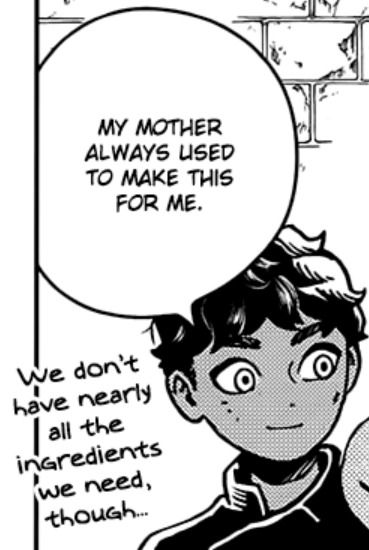

Kabru says he ate this stew as a child, that he hasn't had it in a long time, and that he's looking forward to having it again. He says he is relying on childhood memories in order to make the stew.
If this stew is something Milsiril made for him, why did she stop making it? Why hasn't Kabru had it in a long time? Was there a goat blight for the last 10 years? Did she stop making it to punish Kabru for wanting to leave her? This seems like important information Kui would have told us.
The much more logical assumption is that Kabru's birth mother, who died when he was 7, is the one that made lamb stew, and that's why Kabru hasn't had it in a long time, struggles to remember how to make it, and also why he's so excited to eat it.
This is in direct contrast with the elf fruit cake that Milsiril forced Kabru to eat as a child. Kabru's birth mother made him something he loves, that he is eager to eat again, while Milsiril forced him to eat elf cake so often that it has become his most disliked food.
Kabru and Ryoko Kui never refer to Milsiril as Kabru's mother, the phrase “foster parent” (養母 or 育ての親が, lit. meaning “parent who raised me” in contrast with a birth/blood parent) is used instead in both the manga itself and in the World Guide.
There are several other things like this (how Kabru talks about Milsiril) which I think makes it clear that Kabru probably doesn't call Milsiril mother willingly, and that he goes out of his way to put distance between her and himself. He doesn't hate her, but he doesn't want her to be a part of his life.
Milsiril is a wealthy noble in a society where women are equal to men. It's unlikely that she personally does much cooking, and even if she does cook as a hobby, it's unlikely that Kabru watched her butcher a goat - servants or the butcher would prepare the meat for her.
Milsiril is a fussy eater, and hates most foods. Goat tends to have a strong flavor and is sometimes gamey. I don't think she'd eat goat... Meanwhile, as I stated previously, goat is a delicacy in Nepal, so it would make perfect sense for goat to be a special treat Kabru grew up eating.
Yes, Milsiril sometimes does things she doesn't want to do because Kabru asks... But both examples we have of this, she tries to turn it into a punishment. She explicitly says she's training Kabru so that he'll give up, not because she wants him to get strong and succeed. She wants him to fail. She takes him to her family reunion to prove to Kabru that it's unpleasant, so he won't want to go again. Both times this tactic doesn't work, but she clearly states that this is her intent.
I could go on about this for hours, but this post is really about goat stew!!! But just wanted to throw that in there in case anybody is confused about who exactly cooked goat stew for Kabru.
As I said, there's always the possibility that I'm wrong, but I think the evidence is pretty overwhelming that when Kabru says "my mother cooked this for me" he isn't talking about Milsiril.
#dungeon meshi#delicious in dungeon#kabru#dunmeshi#talking mushroom#dungeon meshi research#kabru of utaya#kabru dungeon meshi#analysis#The Essay#Dungeon Meshi Research
38 notes
·
View notes
Note
I’ve been really curious and meaning to ask - what does Ominis think of the caste system/does it exist where the princess is from? I was just thinking about what Ominis would think when he learns about it, and the concept that your previous life’s actions /karma have influence on how you are born. I feel like it would be really complicated due to his own thoughts on his family/being born blind… how he would adjust to moving to a culture that believes that, and I was wondering if you’d thought about it at all.
Oohohohoho thank you for this question!!! Okay omg so the caste system thing is complicated. Before British colonization, the caste system was more of a social grouping thing based on your chosen career rather than based on birth. These social structures were very malleable. The hierarchy and rigidity of it all and the concept of a ‘lower caste’ came with the British.
For example, India was really LGBT friendly. A lot of our deities are male and female presenting, some have had same sex love interests etc. But homophobia was beaten into us, just like the caste system. Even the word ���caste’ comes from the Portuguese word ‘casta.’ (Don’t get me started on what the Portuguese did to us omg. If you thought the British were bad…)
Now this is a pretty hot debate. Some people attribute the caste system entirely to India and I will say, in some parts of India, the system still remains present, distorted, and harmful. However I think it’s very important to look at our historical record before and after British rule, and acknowledge that the original texts this concept was taken from never spoke of superiority or inferiority.
And no, the caste system (as it is understood today) does not exist where Mira is from.
Now for the Karma thing!!
In our faith, things like blindness are not necessarily considered punishment. Surdas (a devotee of lord Krishna and monumentally significant in Hinduism) has blindness. Ma Manasa is a goddess worshipped in the Northeast who was born with only one eye. Gandhari (mother of the Kauravas in the Mahabharata) blindfolded herself her entire life to live in solidarity with her husband, who was blind.
The concept of karma, dharma, and the maya we live in is REALLY complicated. We believe that the conditions we are born in are chosen by the aatma (the soul) before birth because we choose what lessons we are going to learn during our time on earth. When you die, you understand why you chose what you chose.
So with Ominis, absolutely no one would go up to him and be like ohhh you did bad things in a past life and you’re paying for it now huh lmao 😭
In fact I’m going to go out on a limb and say he’d be treated much better in India than he was in Britain.
ALSO WHILE I HAVE YALL HERE! Please read up on British colonization!! It wasn’t just unfair taxes and peaceful protests! There were genocides and mass famines orchestrated by the British that have fundamentally changed our BODY TYPES because of how intense it was. (Look up the West Bengal famine. It’s really horrific though, so TW.) We were mutilated and tortured and sent to labor camps for wearing our own handwoven clothes or speaking our own language. They stole 45 trillion dollars worth of our wealth and literally tore our country apart.
The Jallianwala Bagh massacre is only one of many examples of British cruelty. There was an unarmed, peaceful protest going on against British presence in the country in a garden in Amritsar. Police locked the place down and opened fire on unarmed men, women, and children. I’ve been to that place and seen bullet scars in the walls and the well that some women jumped into with their children to avoid being killed.
The deep scars of colonization persist to this day. My mother had to pay a fine if she spoke in Punjabi instead of English at her school, and hundreds of regional languages and cultures have been lost.
Sorry this got heavy but people have no idea the atrocities we’ve been through and how difficult it is to bounce back from hundreds of years of oppression, cruelty, and violence.
9 notes
·
View notes
Text
Analysis of Ganji Gupta

Ganji was born in India during a time when Britain still ruled over it.
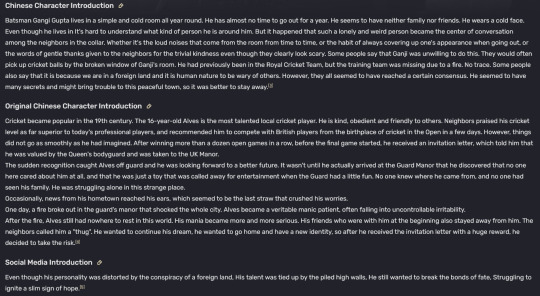
Britain came to India after a sea route connecting Europe to India was found, and Britain initially came due to the economic prospects of trade, but eventually this turned into the desire to acquire territory.
The British presence in India began with the establishment of the British East India Company (the British government having no authority over them at this time). Initially, the focus was trade and acquiring goods such as silk, cotton, spices, and more. Trading posts were established and British communities developed, but eventually they started to meddle in Indian politics and transformed from a trading company to a ruling one. It was at this point that the British attitude towards Indians degenerated (a sense of superiority vs inferiority formed, biased views regarding non-western cultures arose, British disdain increased, and so on). Racism, frustration from the British forcing their own way of doing things (including the English language) on them, policies benefiting the British, and so on contributed to the Indian Rebellion of 1857 (aka Revolt of 1857, First War of Independence, or Sepoy Mutiny).
As a result of this rebellion, the British East India Company was replaced by the British Raj, which was when the British Government took direct control from the East India Company, with Queen Victoria later proclaimed Empress of India. Britain continued to focus on profit and change beneficial to themselves, which led to subjugation and exploitation, and their views of Indians did not improve (still viewed themselves as superior, believed in stereotypes as well as believed Indians were in need of British guidance and governance to civilize them and bring them modernity).
This background is important for Ganji as it is clear this is what he experienced, especially due to Ganji’s 1st letter.
Ganji we know grew up with a talent for cricket, which was the “British national sport”.

His 2nd deduction implies he was a “prodigy”, with many people who knew him recommending him to participate in the regions “open tournament”. We know from Ganji’s trailer that he received “Love, Happiness, Hope and Pride” from playing cricket, showing how much he enjoyed the sport and how much it meant to him.

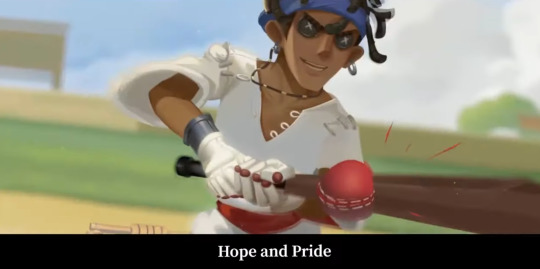
According to this same deduction, combined with Ganji’s backstory, we knew he was a “kind, obedient, and friendly” person, “mild-mannered” (aka gentle and not given to extremes of emotion, which is curious considering later on in Ganji’s story), quiet, and well-behaved. One of Ganji’s backstories states this event (where he was recommended to participate in the Open) took place when he was 16 years old.
During this competition, we know he was skilled enough to earn 12 consecutive wins. The next game after those 12 was a semi-final with the British Royal team. It does not say if Ganji won or lost that match, nor if he won the competition in general, but we do know he was skilled enough to receive an invitation from the Royal team to join them and an offer to help him train. As the deduction uses the word “exception” and applauds him for his performance, I’m assuming he did manage to at least defeat the British team and could’ve won the competition too, but it’s impossible to say for sure right now.


We do know that Ganji saw this invitation as a “good chance” and he “looked forward to a better future”. As a result, he left India with the British Royal team, where he stayed at the Queen’s Guard’s manor. Unfortunately for Ganji, it isn’t until he has arrived that he realizes the truth: “he discovered that no one here cared about him at all, and that he was just a toy that was called away for entertainment when the Guard had a little fun. No one knew where he came from, and no one had seen his family. He was struggling alone in this strange place”.
This was echoed in Ganji’s trailer, which says: “Yet when I was brought here I finally realized, These gentlemen simply needed a proper toy to play with. The funny thing is they were far from gentlemanly themselves. All they longed for were our submission and servitude”.


The terms “submission and servitude” tell us how Ganji was treated while in Britain at the Queen’s Guard’s manor. This is further emphasized by Ganji’s deduction 5, which states Ganji was only given 1 day to train, while 2 others (Oliver and Willie) were given 3 days to train. As that deduction says, despite how Ganji hoped for a better future from this opportunity, the “other sided” ended up only being a “mirage”.

Considering Ganji’s earlier invitation and how he is now being treated combined with only being given 1 training day, it seems the British didn’t want Ganji to be outstanding, which potentially could relate to the feelings of superiority discussed earlier. They didn’t want to feel inferior to someone like Ganji, and thus could further explain why they didn’t give him much training time. In the trailer, we see him picking up balls, and if this was all he was allowed to do, that’d further hurt his ability to train and improve. Lastly, Ganji was only allowed to train on Sundays, and back then, this was seen in Britain as a day of rest, when people didn’t work. This could’ve included cricket as well (there are instances of people being prosecuted for playing cricket on Sunday), which shows how much the Royal team tried to hinder Ganji’s ability to train, meaning he likely wasn’t being trained very professionally.
(If the room we see Ganji in before the fire in his trailer is the one he was given upon arriving at the manor, the state of the room could further show how the Royal Team felt about Ganji. The only identifiable items in the room are the cricket ball, as cricket is what he enjoys, and a blurry picture that we can see Ganji in, which could potentially have been of his home and thus ties to his desire to return to it.)

This fits with Ganji’s design notes which say “his social status and the agenda of politicians did not allow him to have obvious extraordinary talent”. It is because of this the design notes say Ganji’s gentle personality was forced to change into “a personality that takes strong measures to fight against fate”. (It is also right after this that it mentions Ganji being “manic”.)
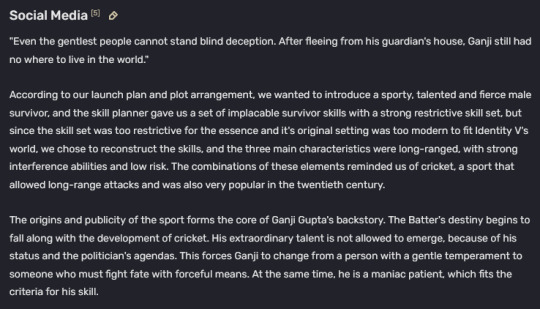
Going to Ganji’s 1st letter, it further reveals how people thought and felt about Ganji and others like him. The part where the author says they need to “take the lead so that the rest of us may get the chance to educate the foolish” fits with how we earlier discussed the British felt they had to govern and civilize the people of India for their own good. This is emphasized with how later the letter says “If it weren't for your insight, he would have spent his life in the mud without ever being touched by the empire's light” and Ganji getting “the chance to lead a civilized life”.
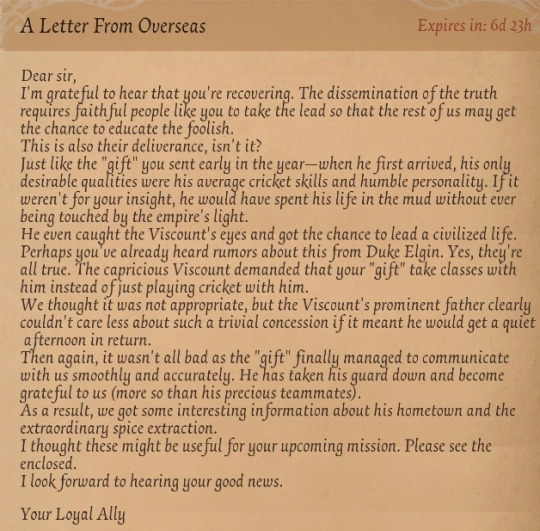
This letter describes Ganji as a “gift” with his “only desirable qualities” being his “average cricket skills and humble personality”. Their sense of superiority is clear hear considering they call Ganji’s skills “average”, yet we know he was talented considering he at least managed to receive 12 consecutive wins in the competition, while the comment about Ganji being “humble” could tie in to how Ganji in his trailer says they just wanted “our submission and servitude”.
Despite how badly Ganji was treated, the one exception was the son of the owner of the Queen’s Guard’s manor. We know he was friendly to Ganji based on Ganji’s deduction 6, which is title “relieved” and shows that the kid thought Ganji was “brilliant” and asked Ganji to play with him. It is possible Ganji is the one who feels “relieved”, and that could be due to actually finding someone friendly in this place. In the JP and CN versions, it potentially has the kid use the term “big brother” for Ganji, so altogether, the kid was likely being honest about his feeling regarding Ganji’s skills and honestly just wanting a real playmate (rather than a toy like the others saw Ganji as).

In this same deduction, it mentions a “well-made board” that has Ganji’s name carved in it. As this is the deduction that involves the son of the manor owner of the Queen’s Guard, it is possible this board was a gift from that kid, and that board may have actually been a bat for cricket.
Going back to Ganji’s 1st letter, it mentions a “Duke Elgin” and a “Viscount”. Based on the mention of “the Viscount’s prominent father” and how this Viscount “demanded” Ganji to “take classes with him instead of just playing cricket with him”, it’s possible the “Viscount” could be the son of the owner of the Queen’s Guard’s manor. We know this boy asked Ganji to play cricket with him due to how cool and talented he thought Ganji was, so it could also fit he might also ask Ganji to take classes and spend other time with him. I’d like to imagine Ganji enjoyed spending time with the boy, as taking classes and playing cricket with him was likely much better than being treated as a toy by the others or languishing along in his poor room.
Ganji continues to play cricket, despite his anger, though he does form a relationship with this boy. If Ganji was 16 during the Open when he was invited to join the Royal Team, and Ganji is at least 21 in game (as he can drink Demi’s dovlin), he was likely subjected to the mistreatment of the Royal Team and owner of the Queen’s Guard’s manor for a fair number of years at least. As we know, he was never able to meet his family while he was at that manor and he was forced to “struggle alone in this strange place”. The “last straw” came one day when he received news “bad news” about his hometown, with his deduction 7 saying he’d received a letter saying “Go home and save them!”

It is soon after this that a fire breaks out and burns down the manor of the Queen’s Guard. The only survivor was the owner’s son and Ganji.

This is also the same time that in his backstory trailer it says “Stop being nice to everyone. I need a new identity. I want to go home. Perhaps that is the only place where there's still hope”.

This matches with Ganji’s last deduction, which is “a letter to home” that he wrote to his mother, saying that “everything’s fine with me. I’m coming home soon”.

Right after the fire starts in one of his backstories, it says Ganji became a “manic patient, often falling into uncontrollable irritability”, so it seems the fire and around this time is when he is first said to be manic. His deduction 9 has a diagnosis saying “Mania, easily irritated. Avoid looking at fire. Suggest locking all windows and doors and staying at home alone”. It is because of his worsening mania that is says people stayed away from him and called him a “thug”, but Ganji only cared about going home.

Once again returning to Ganji’s 1st letter, the end of it talks about getting info on Ganji’s “hometown and the extraordinary spice extraction”. The mention of spices fits our earlier discussion on Britain’s interest in India in part for its spices. This info about Ganji’s home and spice extraction is apparently helpful to whoever this “sir” is and an “upcoming mission” he will be going on. This same “sir” is apparently someone responsible for the idea to bring Ganji to England (though for now I’m thinking he isn’t the Queen’s Guard’s manor owner, who I think is the Viscount’s father).
Considering the talk about Ganji’s hometown and the obvious interest in its “spice extraction”, this could mean this “sir” is someone behind whatever “bad news” came from Ganji’s hometown, and likely the “bad news” and “upcoming mission” had to do with their clear interest in its spices. And if they wanted info on Ganji’s hometown, that could mean one of the few reasons they invited Ganji over was for that info so they could exploit his hometown for the “spice extraction”.
(One side note about Ganji’s 1st letter, but in the CN and JP versions, it says this “Sir” is someone who is recovering their health in “Delhi”, which further shows it’s not the owner of the Queen’s Guard’s manor, who we know was in Britain. It’s possible, if this is someone capable of going on missions and is mentioned regarding “we need… people like you to take the lead” that this “sir” is someone higher up in the government regarding rule of India, who could order a mission to Ganji’s home for it’s “spice extraction”).
Next is Ganji’s 2nd letter, which unlike his 1st (which happens before the fire) his 2nd happens after the fire. We hear he tried to board a freighter. Likely he was attempting to stowaway to return home, but he was caught and taken away by someone working for Duke Elgin. Ganji was placed in a detention center, where he was examined. They mention a “strange scar on his forehead”, which potentially came from the fire that burned down the Queen’s Guard’s manor. We do see Ganji with the owner’s son while the fire burns the manor, so if he had to go in to rescue him, that could have been when.
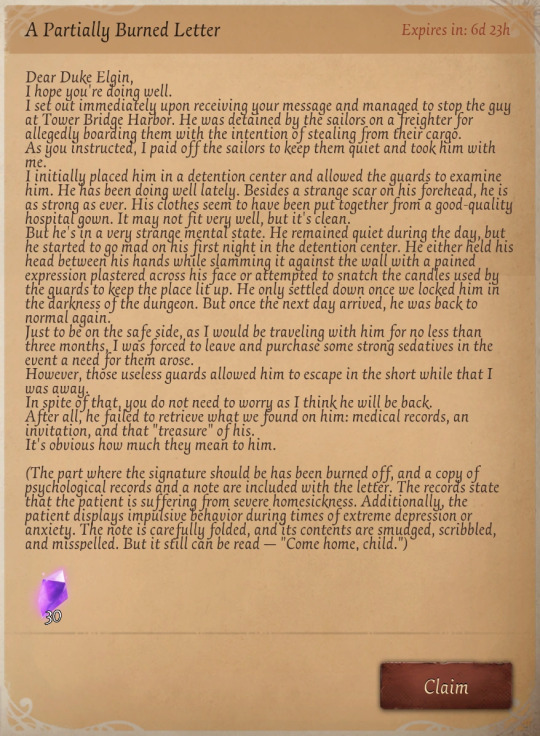
Considering how they say Ganji, besides his scar, seems “as strong as ever” to me kind of feels like they’re still talking about him like an object or one of their possessions.
After this, the letter mentions how Ganji would be “quiet during the day” but would go “mad” at night, with him “either holding his head between his hands while slamming it against the wall with a pained expression plastered across his face or attempted to snatch the candles used by the guards to keep the place lit up. He only settled down once we locked him in the darkness of the dungeon. But once the next day arrived, he was back to normal again”. It was due to this behavior that the author states he went to purchase “strong sedatives” (to be used on Ganji if he went out of control). During this time while the author was away, Ganji was able to escape despite the guards around him. Despite this, the author believes Ganji will return as they still had several of his possessions, including “medical records, an invitation, and that "treasure" of his.
It says the part with the signature had been “burned off”. If Ganji was messing with candle fire while in the detention center, it’s possible he did something similar to this letter if he got ahold of it (unless it’s nothing important).
The mentioned “treasure” is likely the note from home that reads “Come home, child”. Considering it says “child”, there’s a chance this could’ve been written by his mother. We know Ganji’s written to her himself before, so him receiving correspondence from her would make sense.
Another treasure we know Ganji owns is his accessory Cozy Fleece, which is a sheep toy “given to Ganji when he was young” and said to be “one of the several treasures in his luggage”. This was likely another item given to Ganji by his mother, when he was still home, and thus why he treasures it. Another potential treasure could be Ganji’s bansuri accessory, which has the description that mentions its music helps to recall his hometown.
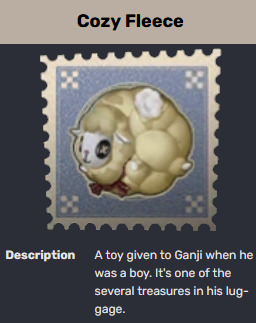
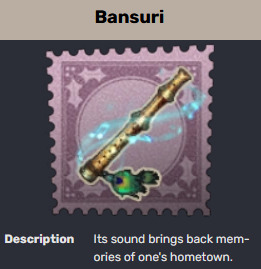
As for the medical records, it says that the patient is suffering “severe homesickness” and displays “impulsive behavior during times of extreme depression or anxiety”. This means that Ganji’s “mania” is caused by his “severe homesickness” in moments when he’s suffering from “extreme depression or anxiety”. That could mean, with Ganji already being homesick for years before the day the fire started, Ganji’s “last straw” when he received bad news about his hometown now makes sense why the fire likely started then. That “bad news” triggered his anxiety and severe homesickness, depressed him when he realized he was stuck at this manor with no quick way home, before then making him impulsive and “manic” in his desire to go home as soon as possible. Whether or not it was on purpose or an accident, it is possible one of his “impulses” resulted in the fire starting, or a confrontation that triggered his irritation causes it to accidentally begin. Maybe a bit of sanity returned to him afterwards, and that could be when he rescued the boy as we see him with the boy during the fire in Ganji’s trailer. But for now, information is scant on the specifics of this event.
Potentially after escaping detainment could be when we see him living by himself like in his other backstories. It’s possible he was in hiding from those that had captured him. We don’t know for sure whether he returned to them for his treasure (it’s possible with how important his note from his mom likely was). We know from Ganji’s backstory that it says he “lived in a cold room with little furniture for years” and “seldom stepped outside during the year”. He had no friends, always looked solemn, and people found it “difficult to get to know him”. Ganji is described as “peculiar and lonely”, and someone his neighbors “loved to gossip about”.
His backstory mentions “random loud noises coming from his room”, which could tie to the behavior he displayed at night in the detention center, when he’d hit his head against a wall.
Regarding Ganji hiding in his room all the time, this connects back to his deduction 9, the diagnosis that suggested “locking all windows and doors and staying at home alone”.
The part about “avoid looking at fire” implies, whether or not he did it and whether it was on purpose or accident, it implies he’d been deeply affected by the fire that burned down the manor. Maybe because of all the feelings (and irritation) he had from how long he spent there, being mistreated and never being allowed to train. Maybe because of the boy he’d formed a relationship too and how this fire took away his home and family, just like Ganji was without his home and family. Maybe any conflict he had if he was somewhat responsible, whether accidentally or on purpose, as his trailer does mention wanting those “gentlemen to repent for their sins” but also because this was a place he’d had such high hopes for regarding his future and now it’s turning to ashes, as well as was a place he’d suffered alone, away from his family, for a long time, but more conflict because Ganji was deep down still a “kind” person (and maybe regretted not saving more people, or regretted if he had a fit of anger and its consequences that day that causes all these events). Just another boy, like the son of the owner of the Queen’s Guard crying at the sight of his home on fire, that was crying out for his family and home as it was threatened or attacked but Ganji unable to do anything about it.
The backstory continues by saying he kept his appearance “hidden” whenever he went out, which could relate to if he was in hiding from the people who’ve been trying to capture him in his letters, or to the mistreatment he potentially receives if people knew where he was from, or to hide the scars on his face from people if he knew how they’d react upon seeing it (as they did describe his face as “horrifying”). It also fits with how his trailer said he needed a “new identity”.
Despite how they treated him, Ganji was said to give “softly spoken words of appreciation to the neighbors’ trivial kindness”, which seems to connect to Ganji’s original personality (as he was described as kind, friendly, and mild-mannered before he came to Britain).
Others debated the reason for Ganji’s behavior, suggesting “regret” (tied to the fire that ended his training with the Royal Team, as other people wouldn’t know the full truth about his feelings towards the Royal Team) or “cautiousness” (from living in a foreign country). Unfortunately for Ganji, everyone decided that Ganji had “a lot of secrets” and “might bring trouble to the town and decided to stay away from him”.
The last thing we hear about Ganji is he still dreamt of returning home, and eventually received an invitation from the manor, offering a “huge reward”, enough for Ganji to use to go home, and he “decided to take the risk”.
Side note regarding Duke Elgin.
I couldn’t find any “Duke” Elgin, but I did find an “Earl” of Elgin. The 9th Earl of Elgin, Victor Bruce, was the Viceroy of India.
I don’t think this is the exact same “Duke Elgin” but it could be a basis for the character (for Netease when designing this).
These were individuals appointed by the British monarch. They represented the British government in India and exercised authority over British India on behalf of the British crown. Victor Bruce served as Viceroy during 1894-1899m which was a particularly troubled period in Indi’s history, and his tenure was not seen as a successful one. During his administration, there was economic and social unrest, a famine, bubonic plague, and the Tirah campaign (Afridi Frontier Rising). This campaign took place in Northwest India and involved the British seeking to restore control over the area after an uprising occurred (with 1 of the challenges they faced being the mountainous terrain).
I don’t think this is exactly where Ganji is from, but this event, as well as all the other issues occurring at the time, could relate to or be a sort of basis (to Netease) for whatever did actually happen to Ganji’s hometown.
Apparently the “bansuri” is a flute connected to north Indian music (with the venu being connected to the south), which could mean (with how the Tirah Campaign happened in the Northwest) Ganji could be from somewhere in the North part of India.
#idv#identity v#ganji gupta#batter#idv ganji#identity v ganji#idv batter#identity v batter#sirenjose analyses and theories
90 notes
·
View notes
Text
have strongly discovered an impulse in myself to be critical of people who have lived here a long time and not apparently tried to learn japanese, especially if the seeming reason is something like they don't think it's important, and especially if they're fellow americans
this disturbs me about myself a little, and is provoking some self reflection, because like. well do you need me to explain why "if you move to a country you better speak the prevalent language or be prepared to prioritize learning it, otherwise i'll judge you" is a bad impulse of thought? back home i truly have not a trace of urge at all to look critically upon people who have lived in the US for a while but don't know english or only know a little because they were prioritizing things other than learning it. that just isn't a thing that occurs to me. and what's more is the things i think it says about someone when they *do* judge people for this are generally unflattering things. obviously.
so i've been interrogating this abt myself a lot and wondering why the hell i feel like that. like i think part of it is that the image i have of a person (especially men, especially americans, especially white) who comes to japan and lives for ten or twenty years and only vaguely considers maybe they should learn japanese is generally an image of someone who considers themselves already fit for and perhaps superior to the norms of the place they've come to, whereas the image i have of a person who comes to america without speaking english, especially someone who isn't white and someone who is in any capacity marginalized, is someone who's going to be treated as lesser and knows it and is in no way doing so out of some feeling of cultural superiority, and the feelings around not actively having interest in or efforts towards learning english (if they indeed are not bothering with doing so, which i kinda don't think is common at least as much as it seems common for there to be long term foreigners in japan who aren't particularly trying to learn japanese) are way way less likely to be something like "i don't need to bother" and more likely to be something like they would totally find it useful to know but have limited time and energy and resources, and they're ultimately in a position of dealing with a disadvantage rather than this very different thing of...i don't know, what seems almost sometimes like a smugness that someone is able to get by fine with just english and doesn't need to bother with the non-english language of the country they're in.
as a related exercise asked myself how i'd feel about americans who moved to india and never tried learning any local language for 20 years. Hmm. I Would Also Feel Negatively I Think, and would make uncharitable assumptions about their attitudes towards their own culture versus the one they were living in. comparable thought exercise result: i don't seem to have this feeling about non english speaking foreigners here? though i also haven't like. run into anyone of that background who has this 'my language is already enough' outlook. there are various ppl i've met who are South Asian or SEAsian immigrants, and i didn't get any such read on them. one can from the post probably gather some of my guesses as to why that may be the case lol.
and there's selection bias because all the people i know like that are folks i met through the cultural exchange association, which does language lessons and other events, so they're likely to be interested in that sort of thing and coming to it more than their peers who don't care about language learning and cultural exchange-- but in and of itself, the fact i'm like, almost the only american that goes to those kind of also contributes to this impression?
anyway. i think it's stuff like that, a sense of me assuming like, a sense of presumed western and american and english speaking cultural superiority on those people's parts (which i know is not really fair) rather than me suddenly becoming culturally conservative and developing some kind of "immigrants must assimilate" attitude (which would be like. actively alarming to discover in myself. this other thing is less so.) but like. i will still keep thinking about and questioning myself. that's a healthy thing to do lol.
8 notes
·
View notes
Text
Experiencing a conflict process about information and communication. The material of information is important, and how the information is communicated is secondary. Questioning information on the basis of semantic hair splitting is often a sign of a bad faith attempt to discredit information.
However, the choices made about how to communicate information are vital to ensuring that information is understood. However great a truth, it can be undermined by bad communication. The aspect of information which should be least relevant to its importance or veracity is by human nature essential, even demanding argument to seek the best formula for the communication process.
This feels overwhelming and discordant tonight, thinking of how often I have watched just the smallest or unimportant word choice shift the tone of information against the fundamentals of communication. Every day I want to stick my beak where it don't belong and just make the little corrections here and there to steer information towards better communication but I don't because those aren't my words and it's not my playground.
Sometimes I've gotten close to understanding this kind of dissociative separation for more distant cultures. Slowly getting better at understanding how to modulate my written tone and word choices to allow information to flow better from me to people in China or Korea or India or Vietnam. It's a strange process to try and express in my language information which will carry accurately through cultural and linguistic translation. I cannot explain it, because it's emotional, rhythmic, intuitive and while there are definitely specific cultural norms, another role of communication is to convey "this is who I am and where I am from," as part of the delicate dance around respectfully conveying information.
I can always pick out the little details that go wrong for me and for other people, I just can't explain what works. I talk to a lot of people from a lot of places and I am tragically monolingual, and the consequence of this is that how I communicate is shaped by finding a way through translation of English into dozens of languages, Icelandic, regional languages in Nigeria or Ethiopia, Turkish, different languages in India. Cursed English is everywhere nearly, and for me it's a sort of code to solve with words, find the words that unlock the right meaning to someone who needs information and I'm what we both have to work with.
So it goes, the information can't move anywhere if the language doesn't make it desirable to understand. What a shitshow.
35 notes
·
View notes
Text
Below are 10 featured Wikipedia articles. Links and descriptions are below the cut.
The election in 1860 for the position of Boden Professor of Sanskrit at the University of Oxford was a competition between two candidates offering different approaches to Sanskrit scholarship. One was Monier Williams, an Oxford-educated Englishman who had spent 14 years teaching Sanskrit to those preparing to work in British India for the East India Company. The other, Max Müller, was a German-born lecturer at Oxford specialising in comparative philology, the science of language.
Adolfo Farsari (Italian pronunciation: [aˈdolfo farˈsaːri]; 11 February 1841 – 7 February 1898) was an Italian photographer based in Yokohama, Japan. His studio, the last notable foreign-owned studio in Japan, was one of the country's largest and most prolific commercial photographic firms. Largely due to Farsari's exacting technical standards and his entrepreneurial abilities, it had a significant influence on the development of photography in Japan.
Girl Pat was a small fishing trawler, based at the Lincolnshire port of Grimsby, that in 1936 was the subject of a media sensation when its captain took it on an unauthorised transatlantic voyage. The escapade ended in Georgetown, British Guiana, with the arrest of the captain, George "Dod" Orsborne, and his brother. The pair were later imprisoned for the theft of the vessel.
Abu Muhammad Hasan al-Kharrat (Arabic: حسن الخراط Ḥassan al-Kharrāṭ; 1861 – 25 December 1925) was one of the principal Syrian rebel commanders of the Great Syrian Revolt against the French Mandate. His main area of operations was in Damascus and its Ghouta countryside. He was killed in the struggle and is considered a hero by Syrians.
Marjorie Cameron Parsons Kimmel (April 23, 1922 – July 24, 1995), who professionally used the mononym Cameron, was an American artist, poet, actress and occultist. A follower of Thelema, the new religious movement established by the English occultist Aleister Crowley, she was married to rocket pioneer and fellow Thelemite Jack Parsons.
Maya stelae (singular stela) are monuments that were fashioned by the Maya civilization of ancient Mesoamerica. They consist of tall, sculpted stone shafts and are often associated with low circular stones referred to as altars, although their actual function is uncertain. Many stelae were sculpted in low relief, although plain monuments are found throughout the Maya region. The sculpting of these monuments spread throughout the Maya area during the Classic Period (250–900 AD), and these pairings of sculpted stelae and circular altars are considered a hallmark of Classic Maya civilization.
The North Norfolk Coast Site of Special Scientific Interest (SSSI) is an area of European importance for wildlife in Norfolk, England. It comprises 7,700 ha (19,027 acres) of the county's north coast from just west of Holme-next-the-Sea to Kelling, and is additionally protected through Natura 2000, Special Protection Area (SPA) listings; it is also part of the Norfolk Coast Area of Outstanding Natural Beauty (AONB). The North Norfolk Coast is also designated as a wetland of international importance on the Ramsar list and most of it is a Biosphere Reserve.
Preening is a maintenance behaviour found in birds that involves the use of the beak to position feathers, interlock feather barbules that have become separated, clean plumage, and keep ectoparasites in check. Feathers contribute significantly to a bird's insulation, waterproofing and aerodynamic flight, and so are vital to its survival. Because of this, birds spend considerable time each day maintaining their feathers, primarily through preening.
The Wells and Wellington affair was a dispute about the publication of three papers in the Australian Journal of Herpetology in 1983 and 1985. The periodical was established in 1981 as a peer-reviewed scientific journal focusing on the study of amphibians and reptiles (herpetology). Its first two issues were published under the editorship of Richard W. Wells, a first-year biology student at Australia's University of New England. Wells then ceased communicating with the journal's editorial board for two years before suddenly publishing three papers without peer review in the journal in 1983 and 1985. Coauthored by himself and high school teacher Cliff Ross Wellington, the papers reorganized the taxonomy of all of Australia's and New Zealand's amphibians and reptiles and proposed over 700 changes to the binomial nomenclature of the region's herpetofauna.
Wulfhere or Wulfar (died 675) was King of Mercia from 658 until 675 AD. He was the first Christian king of all of Mercia, though it is not known when or how he converted from Anglo-Saxon paganism. His accession marked the end of Oswiu of Northumbria's overlordship of southern England, and Wulfhere extended his influence over much of that region.
26 notes
·
View notes
Text

The Magic of Tea
Day 2: Munnar
Inspired by the birdwatching tour Maude and I had enjoyed in Mararikulam, I woke up early again to try my luck. The hills were filled with mist and birdsong. No real sightings, but I didn’t have binoculars anyway. I watched an Indian squirrel (as big as a ferret) climb sneakily through the branches of trees. Not long after, Shajil found me (“bro!”), brought some tea, and let me sit up in the treehouse terrace while he prepared the room for guests who’d booked last night.
I ate a small breakfast that Sarath brought by motorbike, then reluctantly accepted his recommendation to tour an Ayurvedic spice farm nearby. I was skeptical: these are roadside attractions that I rarely enjoy and prefer to avoid. Inside (100r), I willed myself to not totally dismiss the experience as the eager tour guide walked us to different plants and rattled off name after name. Each plant offered a special health benefit: this one for arthritis, that for sinus, others for skin, thyroid, libido, diabetes, and on and on. The most important to Ayurveda are Brahmi (for the brain) and Ashwagandha (for the body). We both knew that I wasn’t interested, though, and I didn’t stay long. I did learn that bay leaves grow on the cinnamon tree, and that coffee trees have a fragrant white flower.
I had come to Munnar to see the tea estates.
Sarath brought me a little farther down the road to a roadside jeep safari business offering various tour packages. I balked (genuinely) at the price: 7,000r ($80). The man quickly reduced to 50 but the language gap stretched to a chasm as I haggled for better understanding as much as better price. I didn’t care about rope bridges, waterfalls, or zip lines. I just wanted to visit the gardens and to try the tea. Preferably not during the hottest part of the day. Sarath couldn’t understand my stubbornness, thought I was being stingy, and grew increasingly frustrated. I felt discouraged and was uncertain about exactly what I was purchasing. I felt trapped. The magic of travel was sputtering.
I had no real choice: I had neither a vehicle nor any idea of where to go. I thought about trying to make my way to town by bus, but it was nearly an hour drive to Munnar. Sarath didn’t like the idea and I didn’t either. I saw that I had to give up control and let the experience be. I agreed to the jeep safari package and snacked on a roadside knish while waiting for the driver.

A dark skinned old man chugged up in a diesel rag top and smiled wordlessly. Sarath gave some instructions and the old man nodded in understanding. Aside: India has three head nods: up and down for agreement, left to right for disagreement, and a wobbly side-to-side for acknowledgment or understanding, regardless of agreement. I could interpret the gestures, but understood nothing of what was being said. It was evident that the old man spoke no English.
Sarath said to call him if needed but I knew that service was poor. I stepped up and in, consciously placing my trust in the silent old man. He deftly shifted a tall rod to put us in gear, footing the clutch and sandal-stepping the pedals as we rasped and jostled toward some unknown destination. I held my breath and my camera and watched again the perfect madness of Indian traffic out the open window.
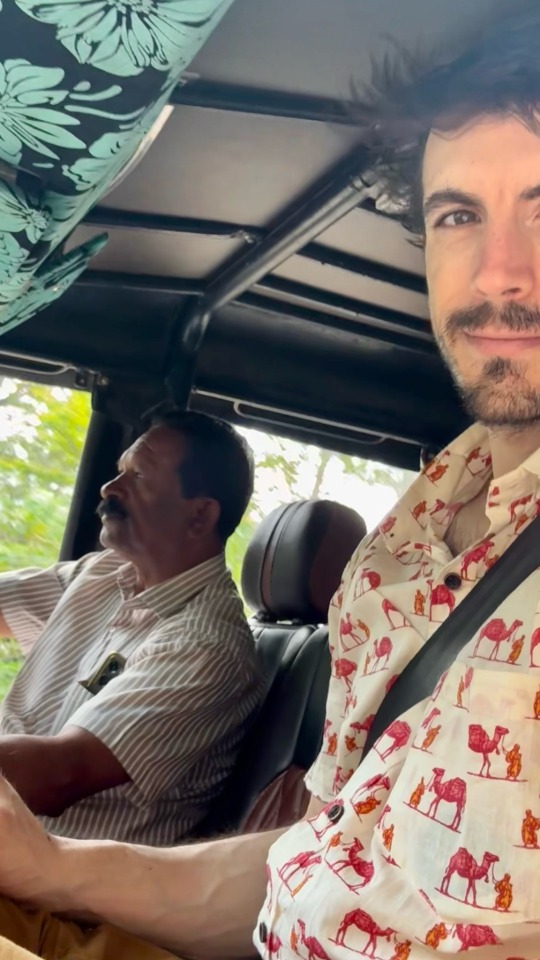
We arrived suddenly some time later. After a wild corner, the landscape was transformed from ruleless jungle to sculptured hedges of tea. This was my first time visiting a tea estate and the sight was incredible. Staggeringly tall cliffs protected rolling, endless, zen-garden-like rows of tea, darkly shadowed and vibrantly green. A narrow road scraped through the estate, following a vibrating and sinuous route as though it had been drawn on the map by an engineer practicing cursive while riding an Indian train car. I felt relief, joy, and gratitude for the return of the magic of travel.

We bumped along and I took in the views. I wasn’t sure if I was supposed to tell him when to stop or if we were heading to a destination. When I couldn’t bear it any longer, I motioned to him and we pulled over. I stepped out and listened again to the birds, watched the wind blow through the bordering trees. Now I accepted the confusion of travel. I hoped the old man understood: this drive and sight alone was all I wanted. We had no words between us, but I shared my enjoyment openly. He seemed to recognize and respect my quiet appreciation of the place.
The tour went on through the acres and acres of tea. We stopped to observe the harvesters. They used metal garden shears with an attached hopper to trim the small tea trees one square foot at a time. I listened to the sshhhlep of blades like scissors cutting hair. The workers bundled the trimmings into a larger basket. “A basket. 1 cup? 2?” I gestured questioningly to the old man, wondering how much work goes into one cup of tea. He smiled without understanding. I felt my aloneness. More, the weight of the world between myself, a foreigner on a private tour, and the workers laboring in front me, watching me back.

The tour ended at a place regularly visited by elephants. I had opted to skip the other package offerings (eg, an over crowded and trash laden waterfall) but thought I’d stay for this one. We parked and waited to see. The old man motioned toward a street vendor selling chai. I watched as the vendor rinsed a cup from a bucket of water on the ground before filling it with bubbling orange masala tea, milk, and sugar. I hesitated and said “no, I can’t,” having had just one real meal since my bout with travelers diarrhea. But I quickly changed my mind, too charmed by the thought of the experience. The old man spoke to the vendor, asking to “make this one extra clean” (I hoped), and I watched as he spooned a pound of sugar into a glass, ladled in the milky broth, steeped and twice filtered in the tea (I asked for a strong cup), then high poured the concoction into a small kettle pot then back to the glass, three times to build a broth, before handing it over to me at arms length with a simple nod. As sweet and hot as a tea can be. Here was my cup.

The elephants never showed up for their drink, and we gave up as the sun went down. The drive back was breakneck, the old man seemingly hanging on himself as the jeep tugged us both stiffly forward. He whipped us along in the fading light, and I cheered him on when he threaded four, five, six inside corners, the jeep swaying on the axles, his arms wide on the wheel, hand catching the shifter and constantly alternating clutch and brake and gas in turn.
We reentered the tea gardens and he stopped abruptly and gestured for me to walk. I found a viewpoint a little ways on and watched from height and distance as some people departed a local bus and another jeep made its own way. The air was softly humid and had a warm color, as though the night itself had been infused with chai. Whatever the cause, it was a moment of magical realism made manifest.
4 notes
·
View notes
Text
The Song of Songs has quite recently (1973) been assigned to the time of Solomon by a distinguished Hebraist, Professor Chaim Rabin of the Hebrew University in Jerusalem. For more than forty years now evidence has been accumulating for some kind of relationship between the cities of the Harrapan civilization of the Indus Valley and lower Mesopotamia during the latter part of the third millennium B.C. and into the second (cf. C. J. Gadd, PBA, 1932). Rabin (205) called attention to the few dozen typical Indus culture seals which have been found in various places in Mesopotamia, some of which seem to be local imitations. He suggested that these objects were imported not as knickknacks, but because of their religious symbolism by people who had been impressed by Indus religion. To the examples of Indus type seals in Mesopotamia cited by Rabin (217n2), we may add a dated document from the Yale Babylonian Collection, an unusual seal impression found on an inscribed tablet dated to the tenth year of Gimgunum, king of Larsa, in Southern Babylonia, which according to the commonly accepted "middle" chronology would be 1923 B.C. (B. Buchanan, 1967).
[...]
Rabin cited a story from the Buddhist Jatakas, the Baveru Jataka, which tells of Indian merchants delivering a trained peacock to the kingdom of Baveru, the bird having been conditioned to scream at the snapping of fingers and to dance at the clapping of hands. Since maritime connection between Mesopotamia and India lapsed after the destruction of the Indus civilization, and since the name Baveru (i.e. Babel, Babylon) would hardly have been known in the later period when trade with India went via South Arabia, Rabin concluded that the Jataka story about the peacock must ultimately date before 2000, an example of the tenacity of Indian tradition (p. 206). Ivory statuettes of peacocks found in Mesopotamia suggest that the birds themselves may also have been imported before 2000 B.C. (cf. W. F. Leemans, 1960, 161, 166), and Rabin (206) wondered whether the selection of monkeys and peacocks for export may not have derived from the Indian tendency to honor guests by presenting them with objects of religious significance. Imports of apes and peacocks are mentioned in connection with Solomon's maritime trade in I Kings 10:22 [=II Chron 9:21], the roundtrip taking three years. The word for "peacocks," tukkiyyim, singular tukki, has since the eighteenth century been explained as a borrowing of the Tamil term for "peacock," tokai. Tamil is a Dravidian language which in ancient times was spoken throughout South India, and is now spoken in the East of South India. Scandinavian scholars claim to have deciphered the script of the Indus culture as representing the Tamil language (cf. Rabin, 208, 218n20). Further evidence of contact with Tamils early in the first millennium B.C. is found in the names of Indian products in Hebrew and in other Semitic languages. In particular Rabin cites the word 'ahalot for the spice wood "aloes," Greek agallochon, Sanskrit aghal, English agal-wood, eagle-wood, or aloes, the fragrant Aquilaria agallocha which flourishes in India and Indochina. The Tamil word is akil, now pronounced ahal. Its use for perfuming clothing and bedding is mentioned in Ps 45:9 [8E] and Prov 7:17 and Rabin surmised that the method was one still current in India, the powdered wood being burned on a metal plate and the clothing or bedding held over the plate to absorb the incense. Rabin supposed that it was necessary to have observed this practice in India in order to learn the use of the substance (p.209). Aloes are mentioned in 4:14 among the aromatics which grace the bride's body. The method of perfuming bedding and clothing by burning powdered aloes beneath them may clarify the puzzling references to columns of smoke, incense, and pedlar's powders in connection with the epiphany of "Solomon's" splendiferous wedding couch ascending from the steppes (3:6-10), bearing it seems (cf. 8:5) the (divine?) bride and her royal mate. Myrrh and frankincense only are mentioned, but "all the pedlar's powders" presumably included the precious aloes from India.
Opportunity to observe Indian usages would have been afforded visitors to India in the nature of the case, since the outward journey from the West had to be made during the summer monsoon and the return trip during the winter monsoon, so that the visitor would have an enforced stay in India of some three months. Repeated visits with such layovers would provide merchant seamen with the opportunity to learn a great deal about local customs, beliefs, and arts.
After a brief critique of modern views about the Song of Songs, none of which has so far found general acceptance, Rabin ventured to propound a new theory based on Israel's commercial contacts with India during Solomon's reign.
There are three features which,in Rabin's view (pp. 210f), set the Song of Songs apart from other ancient oriental love poetry. Though occasional traces of these maybe found elsewhere, Rabin alleged that they do not recur in the same measure or in this combination:
1. The woman expresses her feelings of love, and appears as the chief person in the Song. Fifty-six verses are clearly put into the woman's mouth as against thirty-six into the man's (omitting debatable cases).
2. The role of nature in the similes of the Song and the constant reference to the phenomena of growth and renewal as the background against which the emotional life of the lovers moves, Rabin regarded as reflecting an attitude toward nature which was achieved in the West only in the eighteenth century.
3. The lover, whether a person or a dream figure, speaks with appropriate masculine aggressiveness, but the dominant note of the woman's utterances is longing. She reaches out for a lover who is remote and who approaches her only in her dreams. She is aware that her longing is sinful and will bring her into contempt (8:1) and in her dream the "watchmen" put her to shame by taking away her mantle (5:7). Ancient eastern love poetry, according to Rabin, generally expresses desire, not longing, and to find parallels one has to go to seventeenth-century Arab poetry and to the troubadours, but even there it is the man who longs and the woman who is unattainable.
These three exceptional features which Rabin attributed to the Song of Songs he found also in another body of ancient poetry, in the Sangam poetry of the Tamils. In three samples, chosen from the Golden Anthology of Ancient Tamil Literature by Nalladai R. Balakrishna Mudaliar, Rabin stressed the common theme of women in love expressing longing for the object of their affection, for their betrothed or for men with whom they have fallen in love, sometimes without the men even being aware of their love. The cause of the separation is rarely stated in the poem itself, but this is rooted in the Tamil social system and code of honor in which the man must acquire wealth or glory, or fulfill some duty to his feudal lord or to his people, and thus marriage is delayed. There is conflict between the man's world and the woman's and her desire to have her man with her. This conflict is poignantly expressed in one of the poems cited (Rabin, 212) in which a young woman whose beloved has left her in search of wealth complains: I did his manhood wrong by assuming that he would not part from me. Likewise he did my womanhood wrong by thinking that I would not languish at being separated from him. As a result of the tussle between two such great fortitudes of ours, my languishing heart whirls inagony, like suffering caused by the bite of a cobra.
In the Tamil poems the lovelorn maiden speaks to her confidante and discusses her problems with her mother, as the maiden of the Song of Songs appeals to the Jerusalem maids and mentions her mother and her lover's mother; but neither in the Tamil poems nor the Song of Songs is there mention of the maiden's father. In Rabin's view the world of men is represented by "King Solomon," surrounded by his soldiers, afraid of the night (3:7-8), with many wives and concubines (6:8), and engaged in economic enterprises (8:11). Significantly, however, according to Rabin (p. 213), Solomon's values seem to be mentioned only to be refuted or ridiculed: "his military power is worth less than the crown his mother (!) put on him on his wedding day; the queens and concubines have to concede first rank to the heroine of the Song; and she disdainfully tells Solomon (viii 12) to keep his money."
Since the Sangam poetry is the only source of information for the period with which it deals, Rabin plausibly surmised that the recurring theme of young men leaving home to seek fortune and fame, leaving their women to languish, corresponded to reality, i.e. the theme of longing and yearning of the frustrated women grew out of conditions of the society which produced these poems. Accordingly, the cause for the lover's absence need not be explicitly mentioned in the Tamil poems and is only intimated in elaborate symbolic language. Similarly, Rabin finds hints of the nonavailability of the lover in the Song of Songs. The references to fleeing shadows in 2:17, 4:6-8, and 8:14 Rabin takes to mean winter time when the shadows grow long. The invitation to the bride to come from Lebanon, from the peaks of Amana, Senir, and Hermon in 4:6-8 means merely that the lover suggests that she think of him when he traverses those places. The dream like quality of these verses need not, inRabin's view, prevent us from extracting the hard information they contain. The crossing of mountains on which or beyond which are myrrh, incense, and perfumes all lead to South Arabia, the land of myrrh and incense. Thus the young man was absent on a caravan trip. Even though he did not have to traverse Amana or Hermon to reach Jerusalem from any direction, he did have to traverse mountains on the trip and in South Arabia he had to pass mountain roads between steep crags ("cleft mountains") and it was on the slopes of such mountains that the aromatic woods grew ("mountains of perfume"). Coming from South Arabia, however, one had to cross Mount Scopus, "the mountain of those who look out," from which it is possible to see a caravan approaching at a considerable distance. In 3:6 "Who is she that is coming up from the desert, like pillars of smoke, perfumed with myrrh and incense, and all the powders of the perfume merchant?" is taken to refer to the caravan, the unexpressed word for "caravan" sayyarah, being feminine (Rabin, 214 and 219n29). "The dust raised by the caravan rises like smoke from a fire,but the sight of the smoke also raises the association of the scent a caravan spreads around it as it halts in the market and unpacks its wares."
The enigmatic passage 1:7-8 Rabin also related to a camel caravan despite the pastoral terminology. Rabin's theory encounters difficulty with the repeated use of the verb r'y, "pasture," and its participle, "pastor, shepherd" in view of which commentators commonly regard the Song as a pastoral idyl. His solution is to suggest that the term may have some technical meaning connected with the management of camels.
The list of rare and expensive spices in 4:12-14 reads so much like the bill of goods of a South Arabian caravan merchant that Rabin is tempted to believe that the author put it in as a clue.
Be it what it may, it provides the atmosphere of a period when Indian goods like spikenard, curcuma, and cinnamon, as well as South Arabian goods like incense and myrrh, passed through Judaea in a steady flow of trade. This can hardly relate to the Hellenistic period, when Indian goods were carried by ship and did not pass through Palestine: it sets the Song of Songs squarely in the First Temple period (Rabin,215).
As for the argument that the Song contains linguistic forms indicating a date in the Hellenistic period, Rabin points out that the alleged Greek origins of 'appiryon in 3:9 and talpiyyot in 4:4, the former word supposedly related to phoreion, "sedan chair," and the latter to telopia, "looking into the distance,"are dubious.
The phonetic similarity between the Greek and Hebrew words is somewhat vague, and this writer considers both attributions to be unlikely, but even acceptance of these words as Greek does not necessitate a late dating for the Song of Songs, since Mycenaean Greek antedates the Exodus. Neither word occurs elsewhere in the Bible, so that we cannot say whether in Hebrew itself these words were late. In contrast to this, pardes "garden, plantation," occurs, apart from 4:13, only in Nehemiah 2:8, where the Persian king's "keeper of the pardes" delivers wood for building, and in Ecclesiastes 2:5 next to "gardens." The word is generally agreed to be Persian, though the ancient Persian original is not quite clear. If the word is really of Persian origin, it would necessitate post-exilic dating. It seems to me, however, that this word, to which also Greek paradeisos belongs, maybe of different origin.
[...]
Rabin's summation of his view of the Song of Songs is of such interest and significance as to warrant citation of his concluding paragraphs (pp.216f):
It is thus possible to suggest that the Song of Songs was written in the heyday of Judaean trade with South Arabia and beyond (and this may include the lifetime of King Solomon) by someone who had himself travelled to South Arabia and to South India and had there become acquainted with Tamil poetry. He took over one of its recurrent themes, as well as certain stylistic features. The literary form of developing a theme by dialogue could have been familiar to this man from Babylonian-Assyrian sources (where it is frequent) and Egyptian literature (where it is rare). He was thus prepared by his experience for making a decisive departure from the Tamil practice by building what in Sangam poetry were short dialogue poems into a long work, though we may possibly discern in the Song of Songs shorter units more resembling the Tamil pieces. Instead of the vague causes for separation underlying the moods expressed in Tamil poetry, he chose an experience familiar to him and presumably common enough to be recognized by his public, the long absences of young men on commercial expeditions. I think that so far our theory is justified by the interpretations we have put forward for various details in the text of the Song of Songs. In asking what were the motives and intentions of our author in writing this poem, we must needs move into the sphere of speculation. He might, ofcourse, have been moved by witnessing the suffering of a young woman pining for her lover or husband, and got the idea of writing up this experience by learning that Tamil poets were currently dealing with the same theme. But I think we are ascribing to our author too modern an out look on literature. In the light of what we know of the intellectual climate of ancient Israel, it is more probable that he had in mind a contribution to religious or wisdom literature, in other words that he planned his work as an allegory for the pining of the people of Israel, or perhaps of the human soul, for God. He saw the erotic longing of the maiden as a simile for the need of man for God. In this he expressed by a different simile a sentiment found, for instance, in Psalm 42:24: "Like a hind that craves for brooks of water, so my soul craves for thee, O God. My soul is a thirst for God, the living god: when shall I come and show myself before the face of God? My tears are to me instead of food by day and by night, when they say to me day by day: Where is your god?" This religious attitude seems to be typical of those psalms that are now generally ascribed to the First Temple period, and, as far as I am aware, has no clear parallel in the later periods to which the Song of Songs is usually ascribed.
Rabin considered the possibility of moving a step further in speculation about Indian influence.
In Indian legend love of human women for gods, particularly Krishna, is found as a theme. Tamil legend, in particular, has amongst its best known items the story of a young village girl who loved Krishna so much that in her erotic moods she adorned herself for him with the flower-chains prepared for offering to the god's statue. When this was noticed, and she was upbraided by her father, she was taken by Krishna into heaven. Expressions of intensive love for the god are a prominent feature of mediaeval Tamil Shaivite poetry. The use of such themes to express the relation of man to god may thus have been familiar to Indians also in more ancient times, and our hypothetical Judaean poet could have been aware of it. Thus the use of the genre of love poetry of this kind for the expression of religious longing may itself have been borrowed from India.
Rabin's provocative article came to the writer's attention after most of the present study had been written. It is of particular interest in the light of other Indian affinities of the Song adduced elsewhere in this commentary.
pg 27-33, Song of Songs (commentary) by Marvin Pope
#cipher talk#song of songs#Judaism#This book came up in my Anat research while trying to see what academia currently makes of the theory she's connected to Kali#So this is interesting for that#But I think Rabins theory needs more support just because. Sangam literature to my understanding doesn't date to be contemporary to#The first temple period???#I also skimmed ahead on Pope's own discussion of the Anat-Kali connection and its a bit. Outdated#There was something about primidorial goddess figures or whatever but this book was published in the 60s#Rabin also has a dedicated paper just talking about the words he believes are of Tamil origin in Hebrew and how this connects to trade in#The 1st millennium B.C.
15 notes
·
View notes